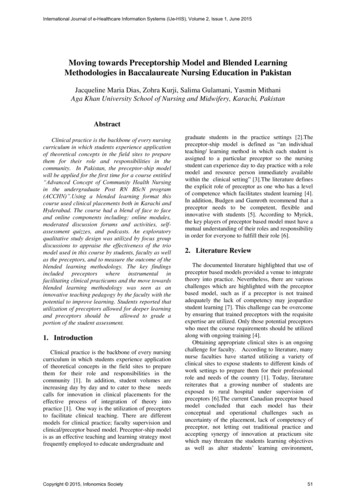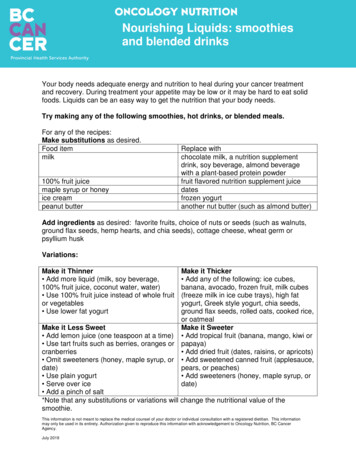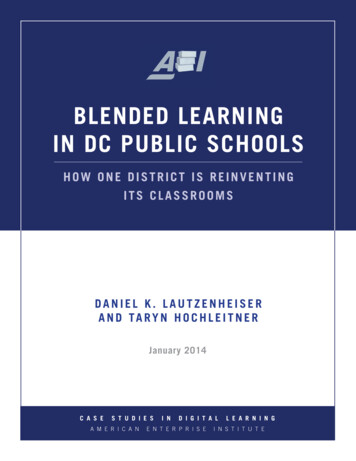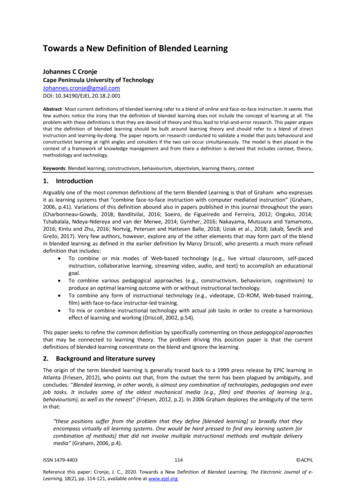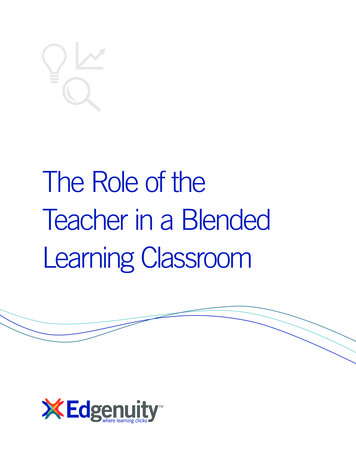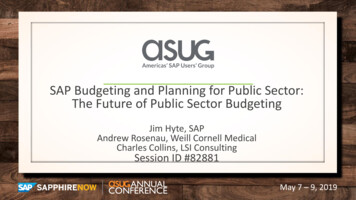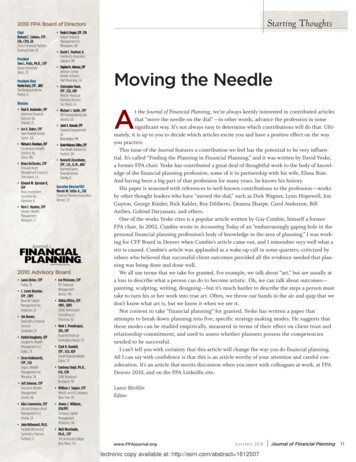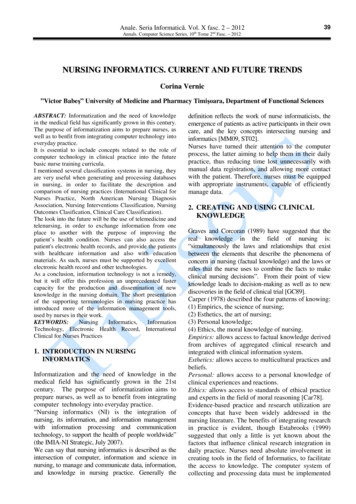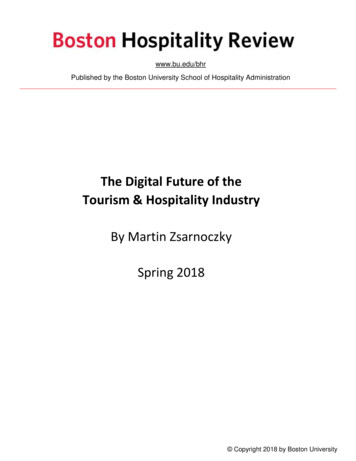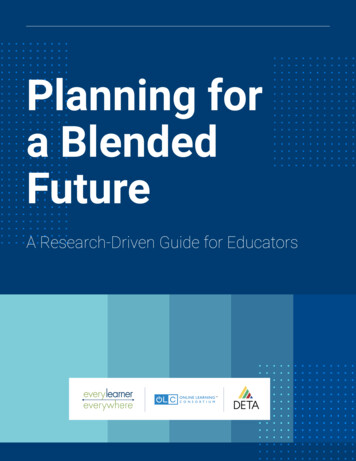
Transcription
Planning fora BlendedFutureA Research-Driven Guide for Educators
Contributing AuthorsTanya Joosten, Ph.D., DETADr. Joosten is a Senior Scientist and Director of Digital Learning Research and Development at theUniversity of Wisconsin-Milwaukee and the National Research Center for Distance Education andTechnological Advancements (DETA).Nicole Weber, Ph.D., OLCDr. Weber is the Assistant Vice President of Learning at the Online Learning Consortium (OLC).Other contributing authors include Margaret Baker and AbigailSchletzbaum, Research Associates at DETA and Abby McGuire, Ed.D.,Educational Researcher at OLC.Recommended citation:Joosten, T., Weber, N., Baker, M., Schletzbaum, A., & McGuire, A. (2021). Planning for a Blended Future: AResearch-Driven Guide for Educators. [Report] Every Learner Everywhere Network. Retrieved from: he work was undertaken on behalf of the Every Learner Everywhere project of WCET(the WICHE Cooperative for Educational Technologies).This work is licensed under a Creative Commons Attribution-NonCommercial-NoDerivatives 4.0 International License.Planning for a Blended Future // About This ResourcePage 2
About the OrganizationsThe National Research Center for Distance Education and TechnologicalAdvancements (DETA) was established in 2014 by funding from the U.S.Department of Education (ED), Fund for the Improvement of PostsecondaryEducation (FIPSE) at the University of Wisconsin-Milwaukee (UWM). Theobjective of DETA is to promote student access and success through evidencebased digital learning practices and technologies. Specifically, DETA identifiesand evaluates instructional and institutional practices through rigorous researchwith particular interest in underrepresented groups of students. University ofWisconsin-Milwaukee (UWM) led a curricular redesign effort, the University ofWisconsin System Hybrid Course Project in 1999 exploring hybrid instructionalpractices and faculty development across and with support of the Universityof Wisconsin System. This work was later continued with support from theOLC Blended Localness Initiative. UWM now offers over 40 blended and onlinedegree programs.The Online Learning Consortium (OLC) is a collaborative community ofhigher education leaders and innovators dedicated to advancing quality digitalteaching and learning experiences designed to reach and engage the modernlearner — anyone, anywhere, anytime. OLC inspires innovation and qualitythrough an extensive set of resources, including best-practice publications,quality benchmarking, leading-edge instruction, community-driven conferences,practitioner-based and empirical research, and expert guidance. The growingOLC community includes faculty members, administrators, trainers, instructionaldesigners, and other learning professionals, as well as educational institutions,professional societies, and corporate enterprises.Learn more at onlinelearningconsortium.orgEvery Learner Everywhere (Every Learner) is a network of 12 partnerorganizations that collaborate with higher education institutions to improvestudent outcomes through innovative teaching strategies, including the adoptionof adaptive digital learning tools. Evidence demonstrates active and adaptivelearning has the potential to improve course outcomes and digital solutionslower the cost of course materials, particularly for Black, Latinx and Indigenousstudents, poverty-affected students, and first-generation students. Our networkpartners represent leaders and innovators in teaching and learning. We havespecific expertise in the adoption, implementation, and measurement of digitallearning tools as they are integrated into pedagogical practices.For more information about Every Learner Everywhere and its collaborativeapproach to equitize higher education through digital learning, visitwww.everylearnereverywhere.org, email everylearner@wiche.edu, or call(303) 541-0206. Follow Every Learner on Twitter @EveryLearnerNet.Planning for a Blended Future // About This ResourcePage 3
ContentsIntroduction 5Executive Summary 8Overview 9Promise of the Blend 10Re/defining the Blend 14Reconceptualizing the Blend 24Moving Forward 35References 37Appendix A 43Planning for a Blended Future // About This ResourcePage 4
PLANNING FOR A BLENDED FUTURE //Introductionlearning“isBlendedour future.”(Joosten, Barth, Harness, & Weber, 2013, p. 96)While many of us through the years have experienced and witnessed the potential of blended (orhybrid) learning in the future of postsecondary education, the promise has never been more realizedthan in the world’s response to a global pandemic and the urgency for academic continuity throughemergency remote instruction that required online learning technologies to mix or replace students’onsite experience with a new online experience. Educators persevered through a global pandemic, acollective trauma of our lives, learning more than ever the weaknesses of technology, the strengthsof togetherness, and the need for thoughtful and inclusive strategic planning. While the challenge,disappointment, and devastation is not without note, the possibilities for the strategic transformation of the future of higher education through blended learning are abundant. By thoughtfully andstrategically considering design and technologies to create meaningful connectedness acrossdistance through active learning pedagogies, real learning can be achieved.Planning for a Blended Future // IntroductionPage 5
Why blended learning, and why now?Blended learning, sometimes known as hybrid learning, is traditionally thought of as a blend ofmedia or technologies allowing for a blend of modalities of learning, face-to-face and online, potentially leading to a reduction in face-to-face seat time in class. Hrastinski (2019) refers to blendedlearning as an umbrella term. Prior to the pandemic, blended learning diffused across the nationand the globe in the start of the 21st century with documented growth and gains in popularity (seeAlexander, Ashford-Rowe, Barajas-Murphy, Dobbin, Knott, McCormack, Pomerantz, Seilhamer, &Weber, 2019; Allen, Seaman, & Garrett, 2007; Picciano, Seamen, Shea, & Swan, 2012). Many notableblended learning researchers describe blended learning as the “new normal” (Dziuban, Graham,Moskal, Norberg, & Sicilia, 2018). As recent as the beginning of 2020, blended learning was identified as a significant digital innovation trend (Joosten, Lee-McCarthy, Harness, & Paulus, 2020).While the pandemic pushed for students to be distanciated from each other and from campuses,an array of technology solutions were quickly adopted with minimal time for thoughtful designresulting in often coincidental mixed models of learning resembling, in part, hybrid and blended learning models. Blended or hybrid learning in the context of the pandemic was a way forstudents to have multiple course delivery options to stay safe from the virus, yet this was notwithout concern, as many noted investment in technology, logistical and technological challenges,increased preparation time, and students’ preferred mode of learning (e.g., Milman, Irvine, Kelly,Miller, & Saichaie, 2020, McMurtrie, 2020). Moving forward, thoughtful, calculated planning ofcourses and the reconceptualization of hybrid and blended learning course models implementedon campuses could occur.With the arrival of a global health pandemic in 2020, the transition of courses to blended andonline learning happened overnight for some universities and colleges. While the DeliveringHigh-Quality Instruction Online in Response to COVID–19 Faculty Playbook released in 2020provides readers concise guidance on course design and teaching in response to the pandemicrequirements, this resource, Planning for a Blended Future: A Research-Driven Guide for Educators,provides information to guide learning and instructional planning processes to prepare educatorsfor the near term post-inoculation. With evidence from decades of research and experiencefrom instructional practice, there is pertinent information that can drive learning and instructionalplanning that is rooted in rigorous empirical research and collective institutional knowledge.“Blended learning, sometimes known as hybrid learning,is traditionally thought of as a blend of media ortechnologies allowing for a blend of modalities oflearning, face-to-face and online, potentially leadingto a reduction in face-to-face seat time in class.”Planning for a Blended Future // IntroductionPage 6
The purpose of this guideThis resource is a collaboration among the National Research Center for Distance Education andTechnological Advances (DETA), the Online Learning Consortium (OLC), and the Every LearnerEverywhere Network. It is designed to serve as a resource for educators — faculty, instructors,instructional staff, instructional improvement staff, instructional designers, learning experiencedesigners and developers, technological support staff, and other stakeholders — to guide strategicplanning for blended learning courses and programs. The guide identifies factors and techniques tobe considered in responsive planning and redesigning courses and programs for post-inoculationeducation in institutions of higher education utilizing the best of both online and onsite instructionto meet the needs of students transitioning from remote instruction and the rapid technologicalinfrastructure investments (e.g., video conference and broadcast solutions). The guide movesbeyond getting started and works to ensure quality in blended learning by implementing researchdriven techniques to positively influence student outcomes while examining lessons learned fromthe emergency remote instruction during the pandemic.“This guide is designed to serve as a resource for educators— faculty, instructors, instructional staff, instructionalimprovement staff, instructional designers, learningexperience designers and developers, technologicalsupport staff, and other stakeholders — to guide strategicplanning for blended learning courses and programs.”Planning for a Blended Future // IntroductionPage 7
PLANNING FOR A BLENDED FUTURE //Executive SummaryConceptualizing what blended learning (hybrid learning) looks like on your campus is an importantstep in ensuring quality learning for your students. Identifying a blended model for your courses andprograms that is derived from research-based, effective practices with documented improvementof student outcomes is critical. Since many of you have had to quickly launch technology-drivenblended options, it is time to strategically plan for a blended model for your campus, programs, andcourses. Planning for a Blended Future: A Research-Driven Guide for Educators identifies factors andtechniques to be considered for responsive planning and redesigning of courses and programs forpost-inoculation education in institutions of higher education. This guide moves beyond gettingstarted with blended learning to help educators realize the best of online and onsite instruction andimplement research-driven techniques to positively influence student outcomes.Who you areKey takeawaysPlanning for a Blended Future is designed toserve as a resource for educators — faculty,instructors, instructional staff, instructionalimprovement staff, instructional designers,learning experience designers and developers,technological support staff, and other stakeholders — to guide strategic planning for blendedlearning courses and programs.By intentionally developing your research-basedknowledge about blended learning and committing to purposeful reflection and actions, you cancreate high-quality blended learning experiencesfor students in your institution’s courses andprograms. Planning for a Blended Future providesfoundational knowledge about blended learning,nurtures a pedagogical shift in thinking, fostersreflection and reframing about blended learningin courses and programs, and provides resources to help you plan for your blended future.“Planning for a Blended Future: A Research-Driven Guidefor Educators moves beyond getting started with blendedlearning to help educators realize the best of onlineand onsite instruction and implement research-driventechniques to positively influence student outcomes.”Planning for a Blended Future // IntroductionPage 8
PLANNING FOR A BLENDED FUTURE //OverviewINTENTION AL KNOWLEDGEINTENTION AL ACTIONSDefine Blended LearningReconceptualize the BlendBlended learning is instruction that blendstechnical, temporal, spatial, and pedagogicaldimensions to create actualized learning.Ŭ Consider student-centered, activelearning pedagogies.Nurture the Pedagogical ShiftThinking strategically about the blend andlearning outcomes, faculty often see theirteaching challenged in a whole new way.They must consider their role to be more thanthat of information suppliers in order to meetthe needs of their students through variousmodalities.Ŭ Focus on closing the loop through theintegration of learning environments.Ŭ Scaffold the student experiencethrough the course.Plan for Your Blended FutureŬ Conduct your own evaluation on yourcampus.Ŭ Rely on solid design principles andstructure to scaffold students throughtheir learning experiences.Ŭ Enhance social interactions and builda community of learners.Planning for a Blended Future // IntroductionPage 9
PLANNING FOR A BLENDED FUTURE //Promise of the Blend“Not all blended learning is equal. Although the differentdefinitions of blended would make you think that it is justabout putting some of the course activities online.thesecret is in the blend.”(Joosten, 2015)KEY IDEAS1Blended learning allows for strategic integration — an amalgamation of face-to-face and online interactions —using a range of technologies, instructional approaches, and pedagogical practices.2The strategic thinking needed in blending a course through instructional design allows faculty and instructorsto carefully align the learning objectives with the instructional modality and technologies that are mosteffective for students.3This strategic integration allows for greater quality than a random mix and match of activities.Research historically has indicated that blended learning can have a positive impact on studentoutcomes including increasing student satisfaction (Dziuban & Moskal, 2001), improving studentlearning and success (Dziuban, Hartman, & Moskal, 2004), and increasing retention and access(Picciano, 2006). Picciano (2006) explains that “well-designed blended learning environments havethe potential of increasing access to a higher education because they improve retention” (p. 100).Research has also found that blended learning is the more effective instructional approach whencompared to online and face-to-face instruction (Dziuban, Graham, Moskal, Norberg, & Sicilia,2018; Galanek & Gierdowski, 2020; Gavassa, Benabentos, Kravec, Collins, & Eddy, 2019; Means,Toyama, Murphy, Bakia, & Jones, 2010). For example, a popular meta-analysis funded by the U.S.Department of Education reported that “[i]n recent experimental and quasi-experimental studiescontrasting blends of online and face-to-face instruction with conventional face-to-face classes,blended instruction has been more effective, providing a rationale for the effort required to designand implement blended approaches” (Means, Toyama, Murphy, Bakia, & Jones, 2010, p. xviii,). Also,research indicates that blended learning can lead to better outcomes for students that are raciallyminoritized (e.g., Broeckelman-Post & Pyle, 2016; Gavassa, Benabentos, Kravec, Collins, & Eddy,2019). Blended learning can be efficacious.Planning for a Blended Future // Promise of the BlendPage 10
BENEFITS OF BLENDED Improvement inaccess, learningeffectiveness,instructionaleffectiveness, andsatisfaction. Increased studentoutcomes, such aslearning, retention,and success. Better outcomes forgroups of studentsof interest, such asracially-minoritized.Blended learning offers faculty and instructors within institutions of highereducation an opportunity to benefit from multiple modes of instructionand use of an array of digital media and technologies inside and outsideof class. Importantly, blended learning allows for the strategic integrationof onsite — often referred to as face-to-face (F2F) — and online interactions, using a range of technologies, instructional approaches, and pedagogical practices. The integration is special. As Picciano highlights (2016),“[t]he word ‘blended’ implies a mixture more so than simply a combinationof components.when two cans of different colored paints are mixed,the new paint will look different than either of the original colors” (p. 6).Thompson (2021) referred to blended using a general systems referencein that the whole (meaning a blended course) is greater than the sum ofthe parts. Hrastinski (2019) describes quality conceptualization of blended learning as the F2F and online components could be integrated in athoughtful, complementary way. The strategic thinking needed in blendinga course through instructional design allows faculty and instructors tocarefully align the learning objectives with the instructional modality andtechnologies that would be more effective for the students with the opportunity to still come to campus or meet in real time (e.g., synchronously)when needed. This strategic integration allows for something greater andbetter than a random mix and match of activities — quality.This integration was often missed during the pandemic’s emergencyremote instruction calling for hybrid and online modes of learning yetis so often the key in blended learning (Joosten, 2015). It was notedearly in the arrival of blended learning that moving things to the web,using a course website, or teaching at a distance is not blended learning(Garnham, Kaleta, & Sudzina, 2003). There is a tendency for faculty andinstructors to not want to redesign or give up any material from their faceto-face course and simply add additional online content and activities toan existing course (Aycock, Garnham, & Kaleta, 2002; Kaleta, Skibba, &Joosten, 2007). Educators and students have felt the pains of the rushto emergency remote instruction and quick technosolution approachesthat may lack design, integration, and engagement. Like many educatorsin response to the pandemic that attempted hyflex options, or here orthere options, Zydney, Mckimmy, Lindberg, and Schmidt (2018) reportedthat one of their lessons learned in their experience was to integrate intocourse design. The need to rethink these areas is evident in the previousresearch as well as the quick and expedient response needed to move toemergency remote instruction. In preparation for post-inoculation coursesand programming, blended learning that is thoughtfully designed andintegrated could be contemplated.Planning for a Blended Future // Promise of the BlendPage 11
“Students’interaction withcontent, theinstructor, andeach other hasnew possibilitiesin designing ablended course.”Blended learning offers numerous possibilities in teaching and learning.The use of technologies allows learning to overcome limits of time andspace, moving beyond traditional classrooms and course scheduling, whilealso still allowing opportunities for face-to-face or real time interaction dueto the advancement in media rich video technologies for class meetingsand access to greater data bandwidth. Graham (2006) discusses the benefits of blended learning due to the ability to overcome these barriers, including improved pedagogy, increased access and flexibility, and increased costeffectiveness while noting the challenges of lecture as the predominantteaching strategy in higher education. Clayton, Blumberg, and Anthony(2018) found that while students perceive traditional environments as moreengaging and online environments as more convenient, they reported thatblended or hybrid environments are both aligned with their
OLC Blended Localness Initiative. UWM now offers over 40 blended and online degree programs. The Online Learning Consortium (OLC) is a collaborative community of higher education leaders and innovators dedicated to advancing quality digital teaching and learning experiences designed to r
